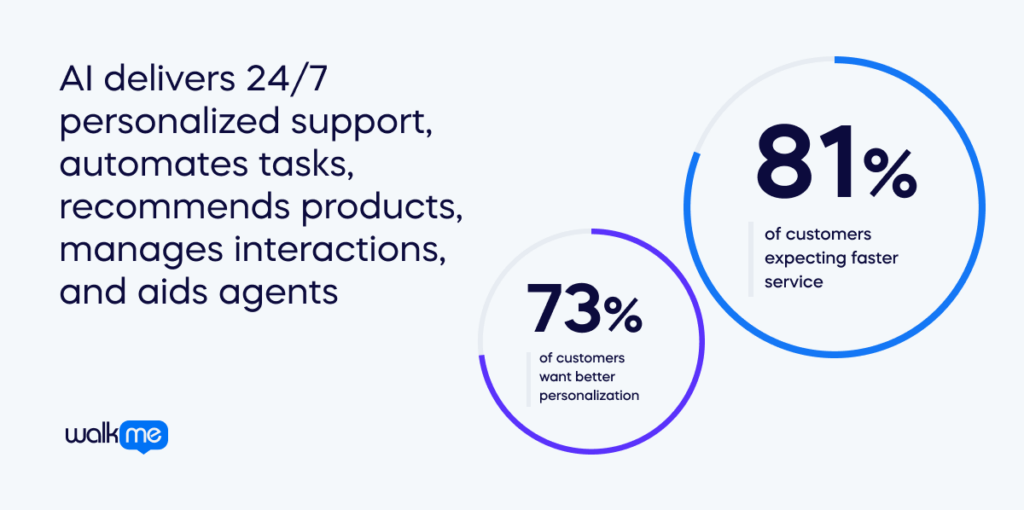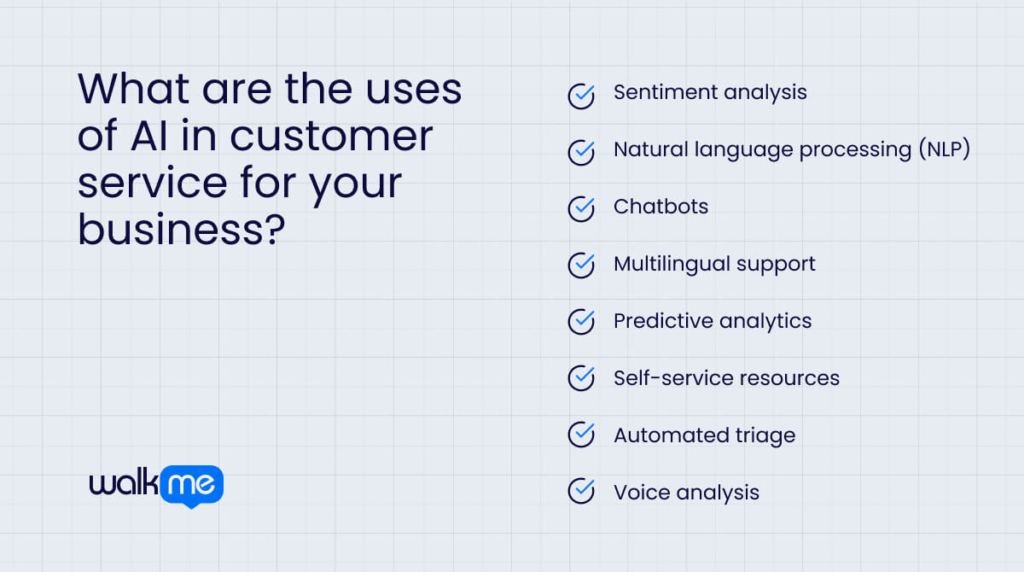AI in customer service has become vital for maintaining a better customer experience. When used effectively, AI helps create connections that feel personal and authentic.
AI brings a human touch to customer service with 24/7 personalized support. It automates actions, recommends products, manages full interactions, supports human agents, and helps with workflow adoption. With 81% of customers expecting faster service and 73% wanting better personalization, AI is key to keeping up.

Research also shows that 60% believe AI will improve work learning, while 55% expect it to boost workplace efficiency. This article will define AI in customer service, explore its uses for your business, discuss implementation considerations, and examine its future.
What is AI in customer service?
AI in customer service is the process of using artificial intelligence to automate and enhance customer engagement. It can answer common questions and understand customer feelings. AI also helps with call routing, gives personalized responses, and boosts agent efficiency.
These tools analyze customer interactions to spot trends. They help businesses find areas to improve their support operations.
Front-line workers will stay important in customer service. But, AI-powered customer service can support their work. It helps your team work more efficiently, respond to requests faster, and anticipate customer needs.
What are the uses of AI in customer service for your business?

There are various ways that organizations can use AI to make customer service easier. These are:
Sentiment analysis
AI-powered sentiment analysis tools track customer feedback, reviews, and social media interactions. They measure customer feelings effectively, helping companies find areas for improvement and respond to customer concerns. These tools also help companies create personalized experiences based on customer preferences.
Natural language processing (NLP)
Natural language processing (NLP) helps chatbots understand human language. It allows them to find key information and intent, making conversations with bots feel more natural and human-like.
With NLP, chatbots can answer a wider range of questions. They better understand customer needs and context, making interactions more relevant and effective.
When combined with generative AI, NLP gives customers relevant, engaging, and empathetic replies. This helps build a stronger connection with customers and improves their experience.
Chatbots
Chatbots support human customer service agents by being available 24/7. They handle basic questions, such as frequently asked questions (FAQs).
These bots can work on different platforms, including popular messaging apps like Facebook Messenger, WhatsApp, and Slack.
AI-driven chatbots respond better to customer inputs than traditional chatbots, which follow fixed scripts. They update in real-time with new information, making interactions feel more human-like. This offers a more engaging and personalized experience for customers who prefer self-service tools.
Multilingual support
Many AI chatbots and conversational tools can create content in different languages. This is especially useful for businesses that work globally.
AI can detect a customer’s language and translate messages before they reach your support team. It can also send automatic replies in the same language as the customer’s inquiry.
If you offer an international product, multilingual customer care can help you attract and keep clients. By assisting clients in their preferred language, you help them get more from your products or services.
Predictive analytics
Machine learning helps AI predict customer behavior. AI-based predictive analytics uses customer data to see needs, behavior patterns, and possible issues.
This method helps companies address customer concerns before they become problems. It also helps them allocate resources better and personalize customer interactions.
Companies can use this data to give tailored product or content recommendations. By understanding individual preferences, they can increase cross-selling and upselling opportunities.
AI can also predict future customer needs and solve potential problems. This ability helps companies remain adaptable.
Self-service resources
Creating a strong knowledge base or FAQ page takes time. Still, self-service resources are crucial for a good customer experience.
AI can help you collect existing information and create content on specific topics. You can use this content to write knowledge-based articles or answer common questions about your product.
This method allows customers and agents to find answers quickly without needing human help. For example, generative AI can analyze customer conversations to find important details and create human-like replies to customer questions.
Automated triage
Automatic triaging through AI means sorting, prioritizing, and sending support tickets to the right customer service agent or team. This process is crucial for smooth support operations. It helps ensure that everything moves in the right direction at the right time.
AI software can automate triaging by analyzing customer data and inquiries. It identifies factors for sorting tickets, such as urgency, customer type, and the support channel. It can also include the type of product or service, required expertise, previous contact, and ticket type.
AI filters and routes customer queries to the agent or team with the right skills. It also checks agents’ availability and workload before assigning cases.
Voice analysis
Customers often prefer support through phone calls, social media, and email over chatbots and online chats.
Voice AI makes it easier to automate call center interactions. These tools can learn to route calls and respond to customer questions. They serve as the first line of support for customer inquiries.
You can use voice AI technology to handle routine customer service tasks, such as directing customers to make online payments.
They could also gather initial personal information before you pass a customer onto an agent. This allows your best agents to focus on more complex issues.
What to consider when implementing AI in customer service?
Before implementing AI in customer service, here are the key factors you need to consider:
Understanding the needs of employees and customers
Understanding what customers and employees expect is important. Make sure the AI solution meets their needs. It should improve their experience instead of complicating it. Customers want a faster, personalized experience, and employees need tools that make their jobs easier and quicker.
Leaders should clarify that AI will not replace jobs. It will complement existing roles. As you introduce AI into your service organization, explain how it will help teams be more productive.
Gather early feedback from employees. This will help you find out what type of AI would be most useful. Employees should also know the timeline for implementation. Provide information about any training that will help them use this new technology.
Review short-term and long-term costs
Adding AI to a call center can take a long time and cost a lot of money. You might also need to hire new people who know how to use AI.
Before you start, consider the cost and whether it’s worth it. Check for extra costs, such as paying for other companies’ software.
You’ll need to train your team to use the new AI tools and make sure they fit with how you already do things. This takes time and money too.
Consider how humans and AI will work together
AI can improve customer service, but it’s important to keep a human touch. Companies should have clear ways for complex issues to go to support reps or managers. Using AI does not mean relying only on automation.
Chatbots and similar tools can help reach out to customers. This reduces the need for human support and makes the customer journey simpler.
Before customers reach out, an AI system can predict their needs and prepare prompts for agents. For example, if a customer wants to know how to set up a direct debit, the AI can provide instructions. When the customer calls, the agent can answer any extra questions.
Put in place feedback and monitoring mechanisms
AI is still growing, so it can’t fully understand complex requests or meet customer needs like a human. This gap sometimes leads to unchecked decisions, which can result in poor experiences, bad outcomes, and legal risks.
To use AI well, companies need strong checks and regular monitoring for customer service. Reviewing customer feedback and performance helps teams improve their AI solutions.
For example, generative AI can give unexpected results or act strangely due to data issues. Monitoring can catch these problems early and help teams fix them quickly. Useful metrics include error rates, processing time, and request rates.
The future of AI in customer service: what to expect?
There are various trends shaping the future of AI in customer service, including:
Conversational AI
Conversational AI uses tools like chatbots and virtual assistants to talk to people. These tools can help customers 24/7, answer simple questions, save money, and give personalized answers to make customers happier.
First, computers understand and organize what people say (Natural Language Processing). Then, they figure out what the person wants and what’s important (Natural Language Understanding).
Conversational AI makes customer service better by talking like a real person and helping people who work directly with customers.
AI-driven personalization
AI personalization helps businesses improve customer service. It gathers customer data, like demographics, browsing history, and social media activity. Using this data, AI can provide targeted recommendations.
For instance, it can provide you with chatbot responses in real time. These tools can now understand questions, remember past conversations, and make the experience smoother.
With AI, marketers can send the right message at the right time to each person, making personalized ads easier. AI uses data from social posts, comments, likes, and shares to create ads that match each person’s interests.
Integration with IoT
AI lets machines learn and make decisions using data. IoT connects devices and systems to gather and share information. Together, AI and IoT can create smarter, more efficient systems.
For example, IoT devices gather data from machines. AI analyzes this data to predict maintenance needs. This approach reduces downtime and repair costs.
Smart thermostats, lighting, and security cameras can also connect to AI. AI then controls these devices to save energy and improve security.
Wearable devices and medical sensors gather health data. AI uses this data to detect early signs of illness and monitor chronic conditions, leading to earlier diagnoses and better treatments.
Adopt AI in customer service to meet evolving customer expectations
AI is becoming a big part of customer success. Today, customers want help anytime, anywhere, and they expect it to be quick and helpful. AI won’t take over from people, but it will work with them to make things better.
AI tools help people solve problems faster. They do the boring stuff, so people can focus on the important, strategic work.
When AI works well with how people work, it fills in the gaps. It understands what customers want and helps people solve problems quicker and better. AI also gives suggestions for helping each customer in a unique way, meeting their need for instant service.
But companies need to consider the cost of AI and how it affects both workers and customers. Keeping data safe and being honest about how AI works is really important to build trust. Customers also care about AI being fair, especially when it comes to bias. Being open about how you train AI and how you use data is key.
Companies should be clear about how they use AI and how they teach it. By being honest, they can make customer interactions better while upholding privacy.

